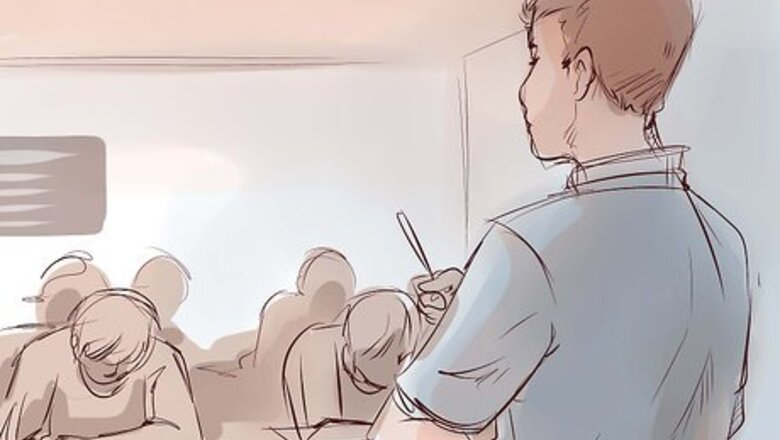
views
X
Research source
Furthermore, the advent of new technologies makes it much easier for students to cheat than ever before. Discovering academic dishonesty depends on your awareness of the classroom, students’ interactions with each other, and other strategies.
Preparing to Monitor an Exam
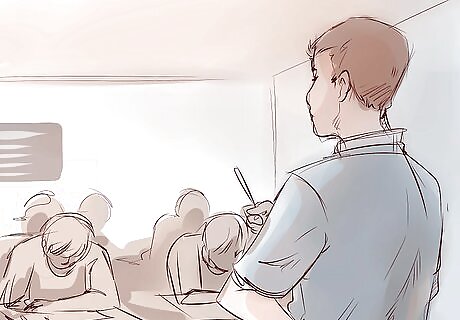
Always be in control of the classroom. Being vigilant in the classroom is the best way to catch students cheating and to prevent cheating from happening in the first place. State your expectations at the beginning of the class and before the exam or test. Make sure your students know the penalties for academic dishonesty. This should hopefully decrease the chance of them engaging in cheating behaviors.

Arrange the testing environment. Arrange desks in the room to spread out students if possible. Alternately, assign seats to students so that they do not sit at their usual desk. Students will not be able to sit next to a friend with whom they could plan to cheat. Ask students to store backpacks, books, or binders underneath their chairs.
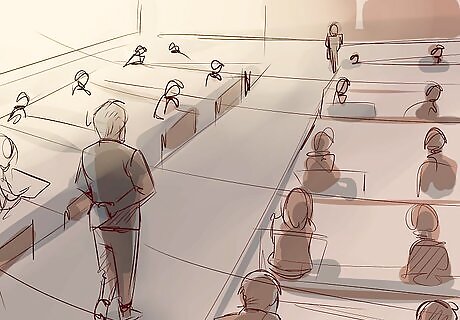
Use multiple proctors. If your test environment is a large space, such as an auditorium, consider having an assistant or two help you monitor the students during the exam. These individuals can roam around the room and cover more ground than a single person can.

Greet students as they come into the classroom. Look at each student as they come in. Glance at their arms, hands and hats to make sure there aren’t any notes written on those areas. Be wary of students who are constantly pulling their long sleeves down to cover more of their arms. Keep in mind that many students are anxious when they come into an exam. Don’t automatically assume that someone who looks nervous is going to cheat. However, it can't hurt to keep a closer eye on said students. In addition, don't assume a student who doesn't appear worried is not going to cheat. Some students have cheated many times before and became adept at their methods, so they may be more confident about the test.
Looking for Cheating Students During an Exam
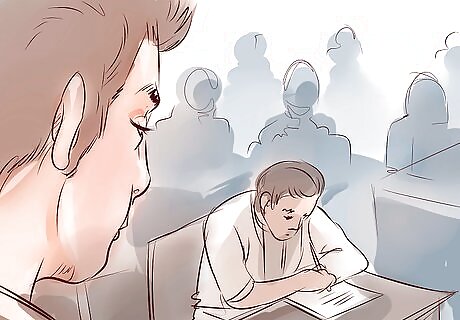
Be vigilant in auditorium settings. If your class is in a large auditorium or classroom, it can be very easy for students to peek at their peers' test papers. If there is enough room, have students space themselves out so that there are empty seats in between students. Monitor the students carefully by walking around the classroom throughout the exam. Use at least two different versions of the exam so students sitting next to each other do not have the same version. This can more simply be done by changing the order of the questions. For example, say you have 8 seats, Seats 1, 3, 5, and 7 get version 1. Seats 2, 4, 6, and 8 get version 2.

Carefully monitor students during tests or exams. Keep your eyes on the students for the entire exam or test. Watch for signs of cheating. Someone might look up at the ceiling pretending to work out an answer, but they are really trying to see a classmate’s paper. Others might look down at their lap constantly, either trying to see their notes poking out of their bag, or at their phone in their lap.
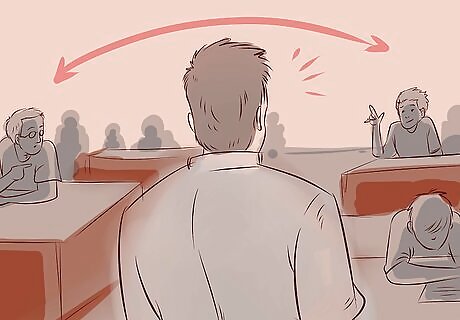
Don’t let a student distract you. A student might come up to the front of the class with a question, which will take your attention away from your classroom monitoring. This gives the other students a few moments to pass notes, look at their phones or otherwise engage in cheating behavior.

Beware of students sending signals. If you notice a student continuously coughing, tapping the bench or their foot, or whispering, and there is a suspicious pattern to these actions, they may be cheating. Watch for nearby students filling in answers at the timing of such signals. Students might have different signs for different answers; for example, on a multiple choice test, if the answer is A, they might tap their pencil. If the answer is B, they might shuffle their test around, and so on. Many people tap their feet or fidget when nervous, and a coughing or sniffing student may have picked up a cold, so don't immediately assume such actions mean a student is helping others to cheat.
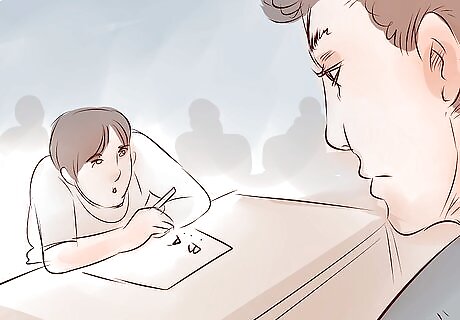
Do not allow any whispering during an exam or test. Whispering to another student is usually a pretty clear sign that someone is cheating or trying to cheat. Tell students that there is no talking allowed during the exam or test.

Watch for students writing large letters on their exams. On a multiple choice test, some students might write a large letter A (or whatever the answer is) next to a question, so that their answer is easy to read from the vantage point of another student. You can prevent this if you use different versions of the test, for example, and make questions 4 and 5 multiple choice on one test and questions 2 and 3 multiple choice on the other version.

Look for writing on the student’s body. One of the most longstanding methods of cheating is to write answers on a student’s hand or arm, in between fingers, or on another body part. Many students are quite savvy about this strategy, bringing alcohol wipes to remove pen ink from their skin before turning in their test. Some students might try writing notes on their legs. They will then wear pants, shorts or a skirt of a particular length that covers the writing, but can be inched upwards to reveal the notes. Teachers should be wary of challenging a student who has writing on their legs; a student might cite sexual harassment if you are looking at his/her legs. Look for writing on clothing. Many students will wear hats to an exam or test and will write notes on the bill of the hat. Ask students to remove hats or turn them around so that you foil their attempts at reading their notes. Other articles of clothing are often used in cheating, such as scarves, sweaters, coats, sunglasses, and so on.

Look out for notes stored in or on objects. Some students use rubber bands to store notes. They will stretch out the rubber band and write notes so they are just barely legible. When the rubber band is unstretched, it will look like it has black lines on it. During an exam or test, the student will stretch and unstretch the rubber band to get the answers. Other students have been known to write notes on very small pieces of paper and store them rolled up in a pen with a clear body.

Be wary of students who use the bathroom during an exam or test. A student may ask to leave the class to use the bathroom. This person might be using that time to check their phone for notes or otherwise look at notes. Before allowing a student to go to the bathroom, have them leave their phone in the testing room (make sure you see with your own eyes that it was left in the room). Some students cheat by planting notes in bathrooms before a test, then visiting the bathroom during the test to look at them. Have a teaching assistant check nearby bathrooms for suspicious notes just as the test begins.
Watching Students’ Use of Technology During an Exam or Test

Establish a no-phone policy. Mobile phones are capable of storing a lot of information that is easily accessible to the user. They can also be hard to monitor. Establish a policy stating that mobile phones are not allowed in the classroom. Strictly enforce the policy so that students are not tempted to use this method.
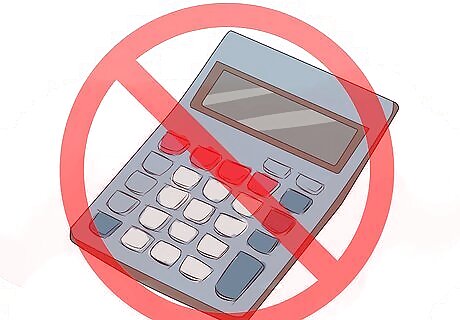
Be vigilant with calculators. Many calculators, especially more advanced ones, are easily programmable. Students can store formulas and equations that enable them to cheat on exams or tests. Carefully monitor use of calculators or prohibit use of them altogether. Another option is to ask your department to buy simple calculators that can be used for exams or tests. This way, students will not need to bring their own. If it is prohibitively expensive to buy calculators for students, you can instruct students to clear their calculators, and check if they have done so.

Prohibit headphones and ear buds during class. Some students might load an audio file of themselves reading notes and listen to this during an exam or test. Watch for iPods, MP3 players or other devices that might be used to transmit information. A common trick students use to hide wired earbuds is to put an earbud through the sleeve of a jacket/long sleeved shirt and hold it to their ear. Others may hide wireless earbuds under their hair or a head accessory, such as a hat or sweatband.
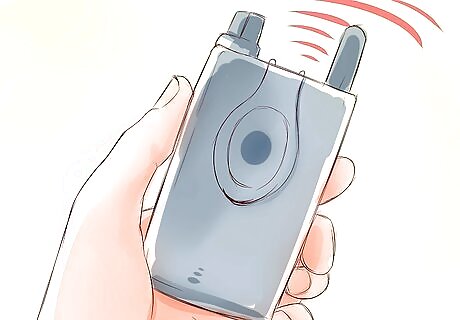
Use a small cell phone detection device. This device is usually small enough to fit discreetly in your pocket and will vibrate when it detects any nearby cellular use. Some cell phone detectors are sensitive enough to allow teachers to walk around the classroom and identify active cell phone use based on proximity. This may indicate false positives, as some apps actively use data. You can prevent this by instructing students to switch their phones completely off during the test, rather than just leaving them on lock.
Catching Students Cheating on Written Assignments

Know your students' writing styles. As a teacher, you will likely be able to recognize the student’s writing style. Watch for changes in writing ability, tone, and overall quality. Trust your instinct when reading students' work. If something looks inauthentic, it probably is. Search online for suspect passages from your student’s paper. Oftentimes, you’ll find the exact same passage in Wikipedia or another website.

Use an anti-plagiarism checker. There are several programs that will detect plagiarism in written work by comparing the paper with other papers in the database and on the internet. Ask students to submit papers to online programs such as Turnitin.com or SafeAssign.

Invite the student into your office to discuss the paper. A student’s paper, written excellently and eloquently, might raise your suspicions if that student does not typically perform so well in class. Invite your student to visit your office hours to talk about the paper. If the student wrote the paper, he/she should be able to talk intelligently about the topic. If he/she didn’t write it, there will likely be less confident discussion of the subject. You still may not have proof of cheating, however, but the student might recognize that you’re aware of their scheme and back down. Many students buy papers from “paper mills” or “essay mills,” which are websites and other services which sell essays for a fee. If your student’s paper is phenomenal, they might have purchased the essay from one of these services. It is difficult to prove this, however, so proceed with caution.
Observing Students Outside of Class

Listen to hallway conversations. Students generally talk to their friends about tests and even about the answers to tests. For example, keep an eye on students who leave your first period class after a test or exam. If they walk a little with a second period student, they may be sharing answers or passing cheat sheets. Creating a different version of the test for each period can prevent cheating by means of students from an earlier period sharing answers.
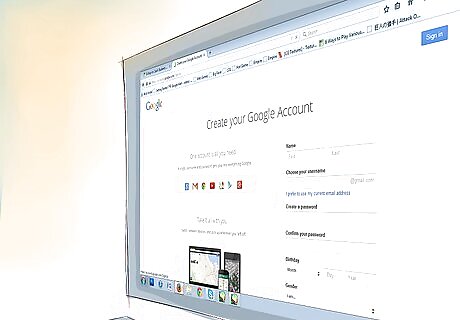
Sign up for the class social media group under an assumed name. Some students will create a private group on Facebook or Google for the class, using it to exchange notes. If the class is large enough, you might be able to sign up for the group posing as a student, using an assumed name. Some course management systems, such as Blackboard, have an option of letting students email each other without the instructor seeing the emails. Change the preferences so that you also see the emails that students send out through the system.

Be cautious with favorite students. Often, students might pretend that they are interested in the class, visiting you in office hours and engaging with the class material. These students might butter you up so that you don’t suspect them of cheating because you perceive them to be good students.
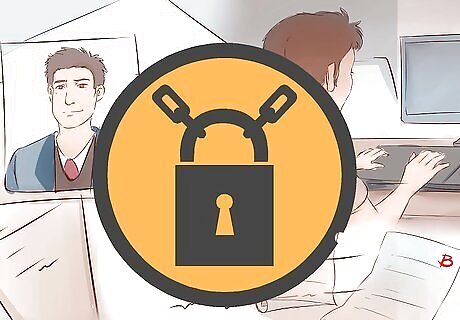
Protect your physical and digital spaces. Do not allow students to be in your classroom when you are not there. Lock filing cabinets and desk drawers to prevent students from looking at tests, assignments, or exams, and watch for this behavior when you are in the classroom as well. Create and memorize complex passwords for the computer and grade book log-ins; do not write this information on paper.
Catching Cheating Students in Online Courses
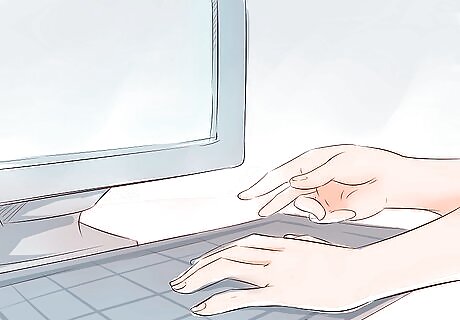
Announce academic dishonesty policies for online courses. For many students, the online course environment may be less clear in terms of what constitutes academic dishonesty. Make sure you establish academic dishonesty policies for your students and give clear examples about what constitutes cheating in an online class.
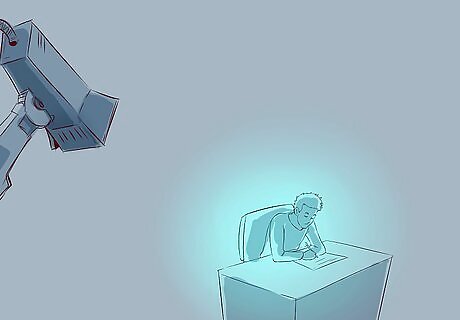
Try webcam monitoring. Some online courses will require that students use a webcam when they take an exam or test. This ensures that the right person is taking the test or exam, and that students are not collaborating with each other on an exam or test. This might also reduce the chance of cheating.
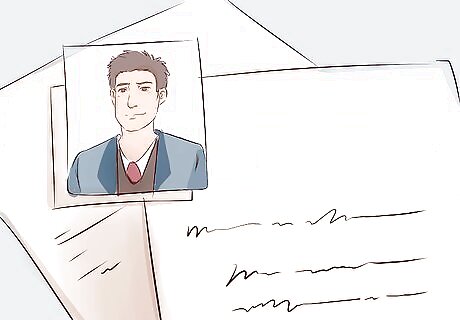
Try signature tracking. Signature tracking is another way to monitor online course participation. This requires a student to verify their identity with photo identification and his/her unique typing pattern.

Administer exams or tests at testing centers. Some online courses might require students to take exams or tests at a testing center so that they are monitored and restricted from cheating.
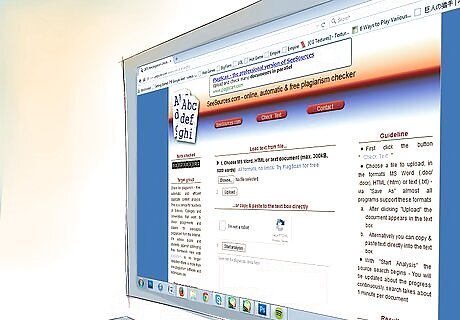
Use an anti-plagiarism checker. There are several programs that will detect plagiarism in written work by comparing the paper with other papers in the database and on the internet. Ask students to submit papers to online programs such as Turnitin.com or SafeAssign.
Confronting Students

Have proof of the cheating. It can be difficult to provide concrete evidence of cheating, but it is important to make sure you have proof before you make any allegations. If you found plagiarism in your student’s paper, try to locate the original passage by searching online. Photocopy a random sample of exams, tests, or major assignments before returning them to students. A common temptation for cheaters is submitting a modified exam for a regrade, especially if they are close and want to be moved across a grade boundary.

Confiscate notes, study guides, or other materials. If you catch a student using notes, study guides, or other materials to cheat on a test or exam, gather these as soon as you discover it. Do so discreetly so as to not disrupt your other students.

Ask a student to reproduce test answers in your office. When you suspect someone of cheating, confront him/her after the exam or test. If they are not forthcoming about cheating, ask them to reproduce the answers for the exam or test. If they are unable to do so, they may have cheated.
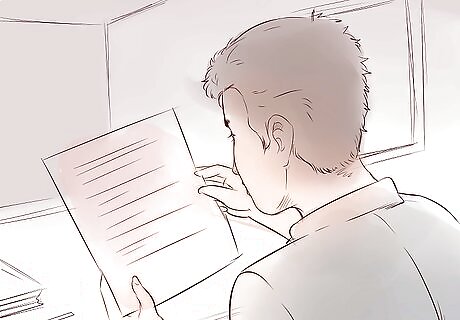
Be familiar with your school’s academic dishonesty policies. Check with your school before applying penalties for cheating. Doing so without following established procedures can put you at risk for legal action.
Changing Your Assessments
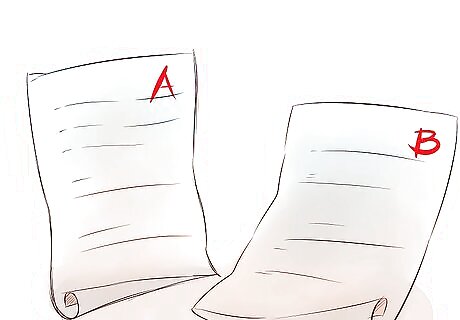
Create two or more versions of the exam. To prevent students from looking at each other’s papers during an exam, create two versions of the test. Pass them out so that the first student in the row has Test A, the next student has Test B, the third student has Test A, and so on. Alternately, use the same version of the exam or test but photocopy them on different colored paper and tell the students that there are two versions. However, show them the tests (don't let the students see the questions) and put them in front of them (on a blank page). Don't use color-coding methods if any students would look for others with the same color. Do not label the exam version on the test. This will make it easier for students to find who has the same version.
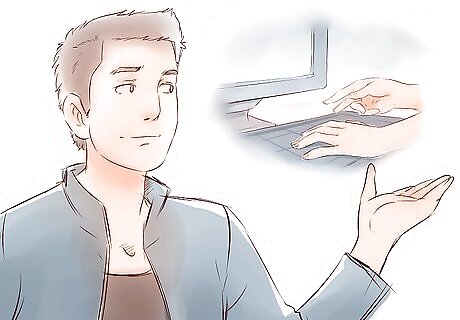
Ask for outlines and rough drafts. Students might try to download entire essays or research papers from the internet, or they might have friends who’ve completed the assignment in a different term. If you ask for outlines and rough drafts of their papers, they will need to demonstrate their process of writing, which helps curb some plagiarism and cheating.

Allow students to bring in a cheat sheet. Nip cheating in the bud by allowing them to cheat, at least by bringing an index card sized cheat sheet to the exam. This may not entirely eliminate cheating, but it will likely reduce some cheating. Keep in mind that when using this method you must monitor your students sharply, as two or more index cards can be disguised as one, and students may exchange cards with different information on them.

Design collaborative assignments. Students often prefer doing team-oriented projects and other assignments, collaborating with each other, instead of working individually. If your assignments emphasize collaboration, students may be less prone to cheating.

Change assessments to emphasize subject mastery. Many students claim that they cheat because they worry about their grade. Learning the subject is the lesser concern. If you emphasize that mastering the subject is the important part, not the grade, students may be less inclined to cheat. Portfolios are often a good way for students to demonstrate mastery, as they can show how they have grasped concepts and improved over time.













Comments
0 comment